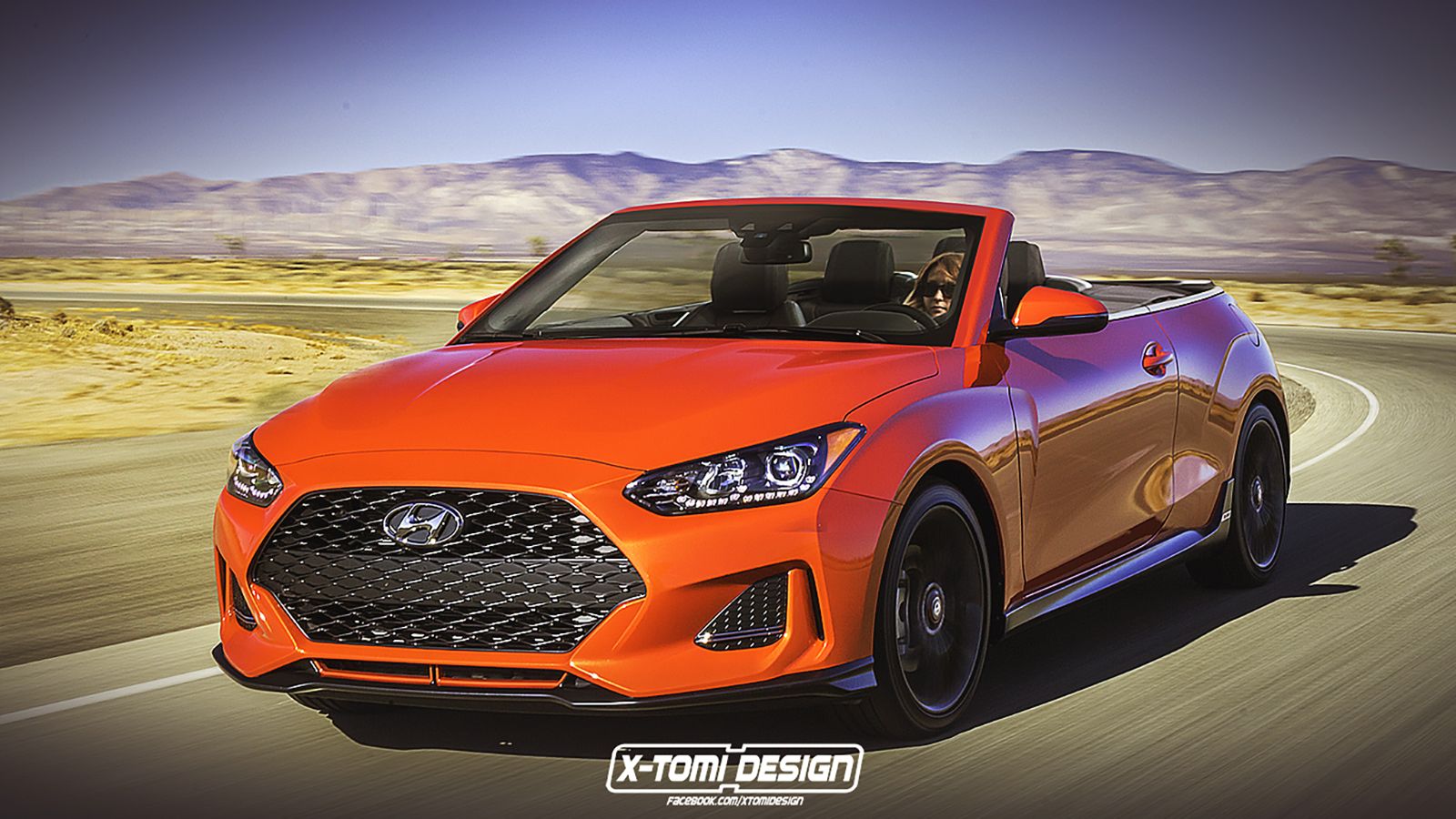The second-generation Hyundai Veloster made its debut at the 2018 Detroit Auto Show. As expected, the Korean automaker put in a lot of work to differentiate the punchy hatchback from its predecessor. The new Veloster’s design still jumps out of the page, but it’s not as funky as the first-gen model that had all sorts of curves and weird edges on it. The tamer-looking second-gen Veloster is more appealing to look at. That car has already been well-received by the public, and the same thing should happen once the new Veloster hits dealerships.
But as good as the new Veloster looks like, can you imagine what a drop-top version could look like if Hyundai decided to build one? It’s unlikely that the company will go that route, but if it did, who’d be excited to see a Veloster Cabrio? Is it something you’d want to be seen driving in? If you can’t picture what that kind of car will look like, let this new rendering from master artist X Tomi Design guide your senses and perception. Convinced yet? I know I am.
2020 Hyundai Veloster Cabrio
- Make: Array
- Model: 2020 Hyundai Veloster Cabrio
- [do not use] Vehicle Model: Array
Exterior
I’m onboard the idea of a drop-top Hyundai Veloster. Judging by this rendering, I’m doubling down on my belief that this should happen. With respect to the hatchback version, the changes Hyundai made to the Veloster’s appearance fits more in a convertible mold. There’s a nice balance to the body that you don’t get to feel on the hatchback by virtue of its configuration. I like the idea that the front end remains the same because it’s one of the high points of the new Veloster’s looks. I also like how it connects to the rest of the body, specifically the way the shoulder line is streamlined all the way to the rear without interruption. It’s clean to look at and the shorter distance between the front and rear gives it a sportier feel to it.
Interior
I don’t suppose the interior configuration of the Veloster will change too much if a cabriolet becomes a reality. The section in the front, including the seats, dashboard, and console layout should remain the same as it was in the hatchback version. I do imagine the rear section being a little more cramped for space if Hyundai goes for a retractable roof setup on the car. There needs to be some space behind those rear seats for that roof. The question I have is whether Hyundai will opt for a more traditional coupe-like look to the hatchback and put the roof storage closer to the seats or if it tries to retain the hatchback layout and extend the storage a little further back. The latter would be interesting to look at, but it could cannibalize what is already a limited trunk space on the car. If it were up to me, I’d still do it because I wouldn’t want to compromise the Veloster’s hatchback DNA. There’s a way to reconfigure that section so there’s enough space for the roof and the grocery bags.
Drivetrain
There’s no point haggling with Hyundai in this section, even if I think the Veloster would do well with more power at its disposal. But I don’t make the calls so I won’t start doing it now. Unless the Korean automaker loses its wits, I don’t think it’s going to deviate away from the new “Nu” 2.0-liter four-cylinder engine powering the new Veloster. The output of the new four-banger is good for 147 horsepower and 132 pound-feet of torque, a good improvement from the 132-horsepower output of the outgoing model.
This is the same engine that we’re going to find on a cabriolet model if Hyundai decides to build one. That said, I’d also like to see the optional 1.6-liter Gamma turbo four-cylinder engine on the convertible model. That engine produces a zippier 201 ponies and 195 pound-feet of torque, more than enough to get convertible-lovers like me to skip on the roof and take the car on those hair-flowing joyrides.
Competition
Mazda MX-5 Miata
Unlike the Hyundai Veloster Cabriolet, the Mazda MX-5 Miata has almost 30 years of legacy and history behind it. There’s a reverence to the MX-5 that’s unparalleled in its segment. That acclaim extends to the current-generation MX-5, which was on the receiving end of a recent update that includes improvements to the rear suspension and power steering, to go with new body and top colors. The Dark Cherry soft top is particularly alluring. On the engine front, the MX-5 still carries the same 2.0-liter four-cylinder SkyActiv engine that produces 155 horsepower and 148 pound-feet of torque. While it could benefit from having a little more power to play with, the MX-5 has never been defined by the number of horses sitting under its hood. Mazda’s iconic sports roadster built its legacy on the foundation of being fun to drive, something that Hyundai can learn from if it goes ahead and builds a cabriolet version of the Veloster.
Read our full review on the 2017 Mazda MX-5 Miata.
Conclusion
This is all speculation so there's no way of telling whether Hyundai's really considering one. There are no indications from the automaker that it's willing to go down this road, but I can't help it. The imagination is running wild on this one. Here's to hoping that someone over there in Hyundai is thinking about the same thing too.
References
Hyundai Veloster
Read our full review on the 2019 Hyundai Veloster.
Read our full review on the 2019 Hyundai Veloster N.
Read more Hyundai news.


